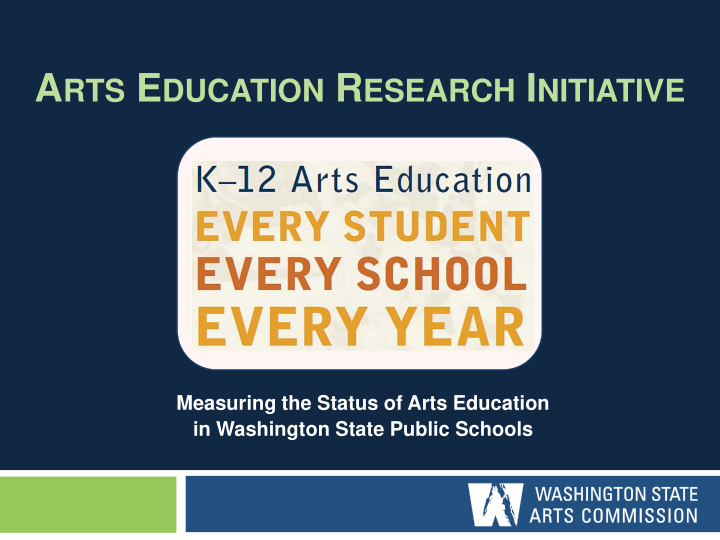



A RTS E DUCATION R ESEARCH I NITIATIVE Measuring the Status of Arts Education in Washington State Public Schools
Every Student, Every School, Every Year “The arts can help students become tenacious, team-oriented problem solvers who are confident and able to think creatively.” – Arne Duncan, U.S. Secretary of Education
Every Student, Every School, Every Year Though the arts are recognized as a core academic subject in Washington State and across the nation, K-12 arts education is fraught with inequities.
AERI – Rationale Current Status: WA has good arts policy There is a gap between policy and practice Needs: Students need more & better arts education Education stakeholders and policy makers need more & better data to collectively work towards this goal
Primary Areas of Inquiry Frequency and Intensity of Instruction Curriculum Assessment Staffing and Professional Development Collaboration with Arts Organizations Funding
Survey Demographics
Findings 33% of elementary students are getting an average of less than one hour of arts instruction per week 47% of schools offer instruction in only of the four primary arts disciplines 8% of elementary schools and 4% of secondary schools provide formal arts instruction in all four arts disciplines 34% of 8th graders attend a school where there is no instruction in visual arts
Findings 63% of principals are dissatisfied with the quantity of arts education in their schools 42% of principals say statewide testing gets in the way of meeting arts learning goals 9% of schools offer no formal arts instruction
Availability of Arts Education Decrease in K-6 hours since 2005 Focus on state testing a possible influence
Arts Curricula Disciplines and grade levels with written curriculum At best: 40% for upper elem. music
Arts Assessments Since 2005, significant change in assessment practice:
The Middle School Challenge WA is below the national average of numbers of 8 th graders taught by FT arts specialists Most districts in WA do not require any arts credits at the middle school level
Staffing Arts teachers account for an average of 6% of school’s teaching staff Average FTEs: Music = 1.16 Visual Arts = .71 Theatre = .12 Dance = .05
Funding District funds are most common and most important, but limited; many other funding sources are required.
Markers of Quality & Action Agenda Elements of Effective, Practical options for Sustainable Practice moving forward Examples of Best Best next steps vary Practices from district to district Yard Stick Everyone can play a role
From Research to Action What’s going on locally? Catalyst for conversation Work needs to be done at all levels
Key Arts Education Partner www.artsedwashington.org A nonprofit organization devoted specifically and exclusively to advancing and increasing arts education in K-12 schools.
More Information: www.arts.wa.gov/education/aeri.shtml Lisa Jaret Arts in Education Program Manager Washington State Arts Commission lisa.jaret@arts.wa.gov
Recommend
More recommend